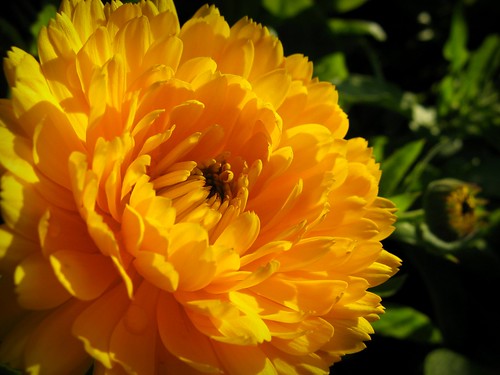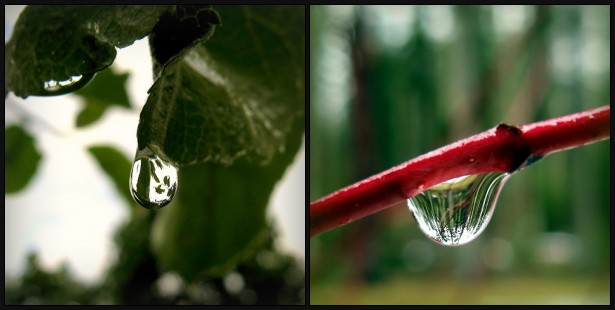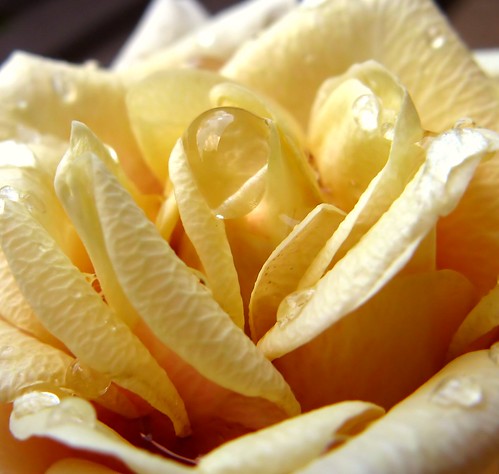skip to main |
skip to sidebar
"Sometimes less is more - less information, but highlighting it in a better way, sometimes better conveys important risk information.”
~Dr. Scott Gottlieb

Autumn love
Location: Kerimäki, Finland
Camera: Canon PowerShot A710 IS
Exposure: 0.005 sec (1/200)
Aperture: f/4
Focal Length: 5.8 mm
Don't get me wrong, I don't even like autumn, perhaps I never will. After all, why would I love it? It killed the bugs and flowers, and I am not exactly the forgiving type. Prior to the death of the greens though, they were bright autumn days and that was when I decided to give minimalism a try. Actually, I wasn't even sure whether I was going it the right way or not, but my previous visits to the photostream of one of my photography idols gave me ideas.
Leaves were the most available at the time because they were everywhere. I tried my very best to follow the rule of thirds. Additionally, I wanted dramatic contrast of colors that's why all of the shots had the blue sky in the background. It worked well, at least according to the reviews of my Flickr contacts. I used flash in some of the photos but it was on a low setting. Less detail means less amount of post-processing work to deal with, sometimes the image may not even require any modification at all. Ain't it easy?

Autumn colors
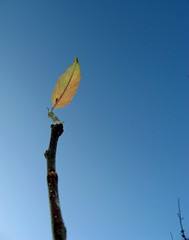
Alone but standing tall
The key is to make the subject interesting given the minimal information in the image. Applying simplicity as a technique will be very effective. If the subject is a flower, you wont need the distracting weeds in the background. Give the subject more room to breathe. The right choice of perspective can also make the shot stand out, no matter how tiny the subject may be. The viewers may only minimal detail, but creativity should always be at its maximum level because it will give the photo a spanking impact.
“Life is all about timing... the unreachable becomes reachable, the unavailable become available, the unattainable... attainable. Have the patience, wait it out It's all about timing.”
Stacey Charter

Camera: Canon PowerShot A710 IS
Exposure: 0.002 sec (1/640)
Aperture: f/4
Focal Length: 5.8 mm
I mentioned in one of my previous entries that beginners should try to take photos of calm insects like beetles. Lady bugs are usually easy to take photos of, but it's important to capture it while doing something cool like attacking aphids or when it spread its wings. Needless to say, you have to watch its every move and be quick enough to capture them. If you don't have the patience, don't bother giving insect photography a try. Concentrate on still life photography instead.
I have some photos of lady bugs that look interesting simply because I was quick enough to press the shutter. Thanks to the adrenaline rush that I experience whenever I see cute insects. It makes me so alert, my heart beats faster than usual, I am just very focused on the bug and I wouldn't care about what is going on around me. Sounds like a case of love-at-first-sight? I think so too :-) What I find surprising is the fact that I never get shaky, which is great thing because until now I am still to experience how to use a tripod. Someday I will use one, that is when I already have Parkinson's disease.
Alright, so timing is important to make captures interesting, but how likely is it that something special is about to happen while closely monitoring the movements of the ladybug? If the ladybug is not comfortable with its surroundings of course it will fly away. It usually happens when it has no where else to go or based on my experience, when it's on human skin, it won't stay there for long so be prepared to press the shutter before its flight. When disturbed, the lady bug will release a yellow smelly substance from its joints so it's best to avoid touching it, unless you want a dirty bug as a subject.
Some say that they would love to take photos of ladybugs but they don't know where to find them. Lady bugs are usually on leaves of aphid-infested plants like roses. I also saw one ladybug crawling on a raspberry. These beetles are tiny, about 4-10 mm long but you will spot those spotted beauties because of their colors which stand out against greens. Knowing how the ladybugs look like during their early stages of life will also help you find them later on when they are already the photogenic insects that many people love. Here's a photo of ladybugs in their ugly phase:

I wanted to kick my self because I didn't get to witness the transformation of this lady bug:
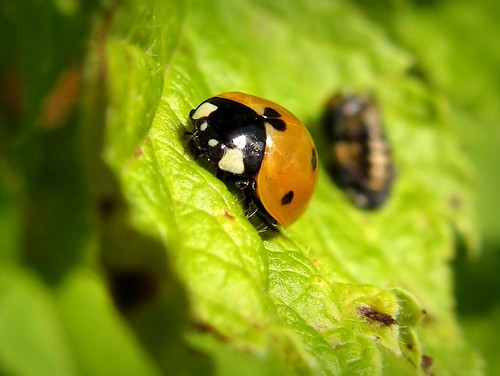
It would have been great to have photos of it as it come out of its larva shell.
A few days later, guess what happened? I arrived at the scene too late again! Just like those cops in some movies. But at least you can see the larva shell better in this photo:

Next summer I will watch them like a hawk. But for now let me show that there were instances when I was on time:
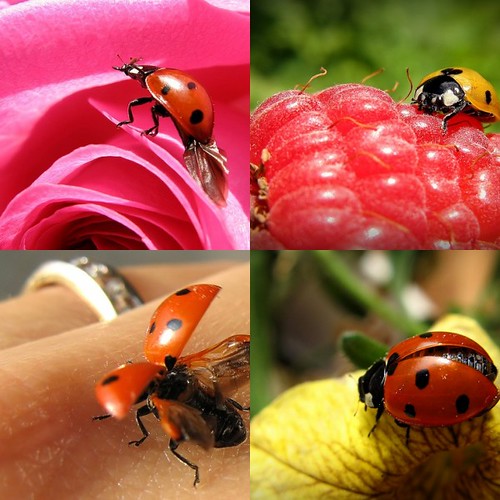
1. Ooops, dead-end!
2. Climb every berry
3. seconds before take-off
4. For Cara
Those shots are not perfect, but they are unique. I think they are good enough, considering the fact that those were produced by a 7.1 mp compact camera. Again these are proofs a small camera doesn't always produce images of poor quality. It's the lack of passion for the craft that makes photos look dull.
"Photography is still a very new medium and everything must be tried and dare... photography has no rules. It is not a sport. It is the result which counts, no matter how it is achieved"
~Bill Brandt
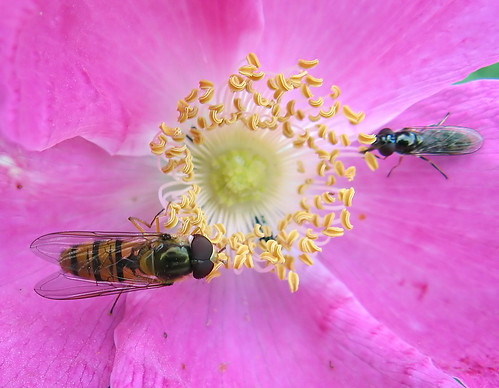
Pollen time
Camera: Canon PowerShot A710 IS
Exposure: 0.017 sec (1/60)
Aperture: f/3.2
Focal Length: 5.8 mm
Modifications: adjusted brightness & contrast levels, cropping, noise reduction
I started taking nature photos in the spring of 2007 using a Canon PowerShot A540. Back then, all I wanted was to have photos of ducks to upload to my Multiply page. Then I found out that the forum I frequent has a thread where members share their digital shots. I posted links to my photos and I am thankful because I got helpful tips from the regular posters of that thread. I realized that there is more to photography than pressing the shutter.
I am more famous in breaking rules than following them. So wasn't really happy when I read about the rules of photographic composition. I researched about the Rule of Thirds which sounded too complicated for me. Any sentence that mentions numbers will always be too difficult for me to understand. I was also a little hesitant to learn, because to me a hobby is supposed to be for fun, if there are rules then it would be a bit stressful. I got bored every time I read about basic stuff about photography until I realized that if I will not change my attitude towards learning new things, then I will never improve. My photos would probably be worse than photos taken by a 6-year-old. So I started to listen to criticism and I also followed my husband's advise and that was to think before pressing the shutter.
It took me a while before I understood what the rule of thirds is about. It's really very simple. The subject should not be in the center of the photograph. Divide the image by 2 vertical lines and 2 horizontal lines, the important elements of the image should be within the thirds. In the illustration below, the strong points must be in the red crosses.

Take the photo below as an example:
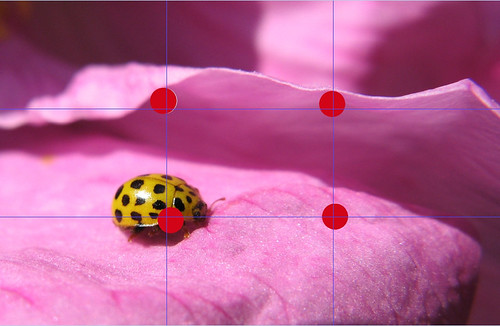
It's just the right spot for the beetle. Because if it was on the next dot, then there would have been useless empty space behind the beetle. It would also look like it was going out of the frame, thus directing the viewer's attention off the image and I don't want that to happen. The title of the photo is Journey, hence I wanted more space on the direction where the beetle was going. To view the image without lines click here.
I believe that I also observed the rule of thirds in this photo:

Bid me farewell
Exposure: 0.017 sec (1/60)
Aperture: f/3.2
Focal Length: 5.8 mm
I don't follow the rule of thirds all the time. In flower macros, for example, when the flower's center look very interesting, expect me to forget about the thirds. The shape and form of the subjects would sometimes dictate whether you should follow the rule of thirds or not. If you want to highlight symmetry, it would be fine if the subject is centered. Here are pieces of evidence showing that sometimes centering works:
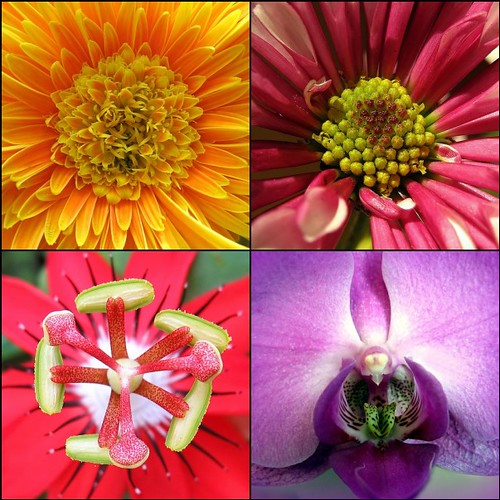
Dare to break some rules once in a while. Don't be afraid of criticisms, bear in mind that you can never please everyone. If you are a newbie, don't feel bad if someone occasionally tells you where you went wrong. Never make your low-pixel camera as the scapegoat for poorly-composed shots, after all, you were the one who made that camera work by pressing the shutter. The photo is either good or bad because of the person behind the camera. Why? Because we have brain cells and our cameras don't. To me the number one rule is to make use of your brain, of course you can break this rule.. at your own risk.
“Never bend your head. Always hold it high. Look the world straight in the eye.”
~ Helen Keller
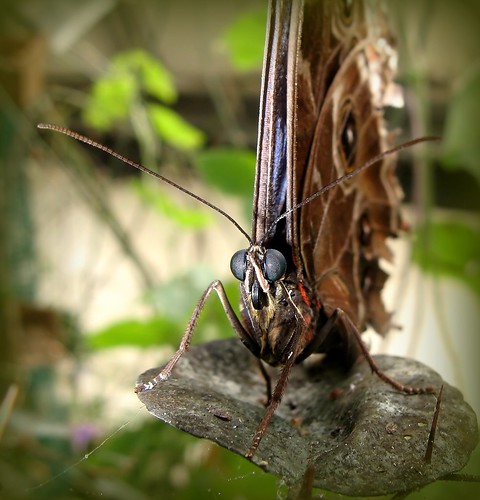
Straight in the eye
Camera: Canon PowerShot A710 IS
Date & Time: July 27, 2008 at 11.23am EEST
Location: Joensuu, Finland
Exposure: 0.017 sec (1/60)
Aperture: f/3.5
Focal Length: 5.8 mm
Modifications: cropping, adjusted brightness, contrast & color levels, noise reduction
Among the rules of animal and people photography is to focus on the eyes. It's a rule that I never questioned. I don't know about you, but I would definitely hate it if someone would take a photo of me and the camera is focused on the strands of gray hair on the crown of my head. Other than the fact that it would expose the ugly side of me, I am quite sure that no one would find it interesting.
According to Frank H. Philips: "On many bugs the eyes (and even bug “pupils”) lend a dramatic connection between them".. Hence photos focused on the bugs' eyes look very interesting. Since the day I read Frank Philips' tip, I have always aimed for the insects' or spiders' eyes. It is not easy, but eventually, you will get the hang of it. You just have to keep on practicing.
The major challenge in insect macrophotography is of course the size of the insects. To avoid immediate disappointment, look for bigger insects to practice on. Rhinoceros Beetles have big eyes and they are rather calm which means that you can take a hundred of photos of it if you want to. But those huge beetles are quite rare. Lady bugs and shield bugs are tiny but quite easy to photograph. Once you have spotted those critters, take as many photos as you can from different angles. Head-on perspective is my favorite. It is very challenging but I find it really cool, a hundred times more intersecting than a boring aerial view like this pic. Insects are beautiful and when photographed the right way, I think a lot of people would appreciate them more. I am quite pleased with the comments I got when I uploaded these pics:
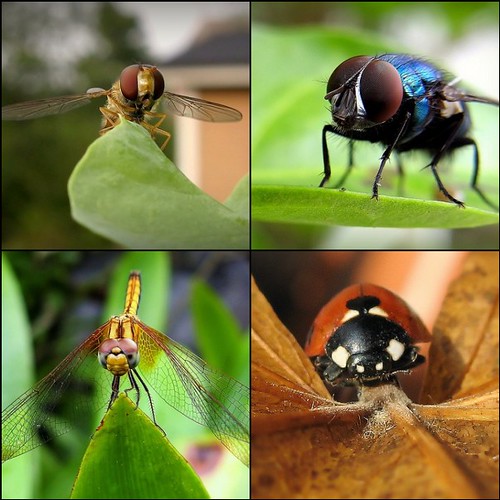
1. in your face!
2. Fly
3. I dare you to move
4. face to face
To be fair with the bugs, I took a photo of my eye:
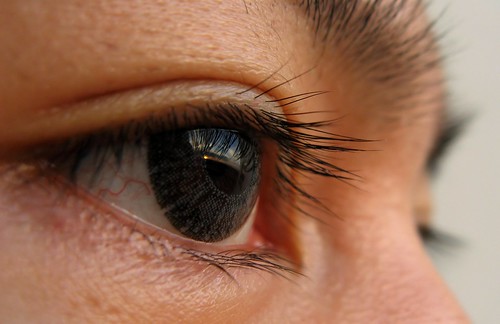
Vision of a sunset
Camera: Canon PowerShot A710 IS
Exposure: 0.017 sec (1/60)
Aperture: f/2.8
Focal Length: 5.8 mm
To view the large size click here
If you have the right equipment for macrophography then good for you. Your photos shouldn't suck, if they do, hmm shame on your gears :-) But if you are a P&S user like me, never ever focus on the limitations of your camera. The key is to get very close to the subject. Concentrate your efforts on following the basic principles of photography and you will never go wrong.
“The policy of being too cautious is the greatest risk of all.”
~ Jawaharlal Nehru Stalked!Camera: Canon Powershot A710IS
Stalked!Camera: Canon Powershot A710IS
Location:Punkaharju, Finland
Date & time: 5.36pm EEST
Exposure: 0.017 sec
Aperture: f/2.8
Focal length: 5.8mm
Modifications: cropping, adjusted brightness & contrast levels
I am keen on learning more about insect photography. I always read tips from some forums and blogs of professional photographers. Sometimes reading about some so-called tips make me wince. I was shocked to find out that some photographers resort to freezing bugs so that they could get 'better' photos of them. I think that is very wrong to sacrifice a bug's precious life for the sake of art. Talk about some human's selfish needs. No wonder so many species are now extinct. In my opinion such form short cutting defeats the real purpose of nature photography. There's nothing like capturing nature's priceless moments.
In case you find nature macrophotography very interesting, then by all means give it a shot. It's not exclusive to people with high-end cameras, if it was then I would not have the thousands of bugs and flower close-ups that are in my hard disk right now. I already have an entry about flower macros. For now I want to share with you how to find and stalk bugs in their natural environment.
One thing that you should do as you walk close to the subject is to adjust your camera settings. Lower the exposure if the light is too harsh. Do you think you need to change the white balance? Do all the necessary adjustments prior to getting up close to the bug.
Spiders
It's quite easy to find spiders. If not in their web, they are usually on leaves or crawling on the ground. These 8-legged creatures are not insects. They don't have wings, but once they sense your presence they will disappear in flash. Why? Because most of them have 8 eyes that's why they can easily detect human presence. Getting good photos of them is a bit difficult, but not impossible. Just don't do anything that will startle them, move very slow but press that shutter like a maniac. If you are very close, make sure that your camera won't accidentally hit the leaf or whatever the spider is on because it's going to blow your chance to take more photos. In a blink of an eye spidey will be somewhere else. Here are two spiders who didn't mind me taking photos of them:
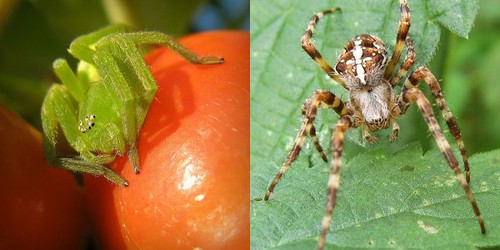
1. Greenie
2. Spider on a stinging nettle
Bumble bees
These ever buzzing winged insects are very restless especially if they are surrounded by plenty of tiny flowers. A bumble bee will just stay on a flower for a few seconds. They are normally too busy to get intimidated by the camera, but you have to press on the shutter as fast as you can. I haven't had the luxury of time to use manual focus on bumble bees. My camera is always on full auto mode whenever I take photos of them. My best shots bumble bees:
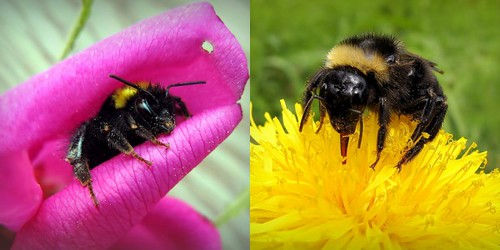
1. Coming out of the shell
2. Another day in the office
Honey bees
If bumble bees are always in a hurry to get things done, honey bees are different. They are quite methodical. Hence, easier to photograph. You can follow it's movement from one flower to another and you can take many shots of it because it stays on a spot for a minute or more.
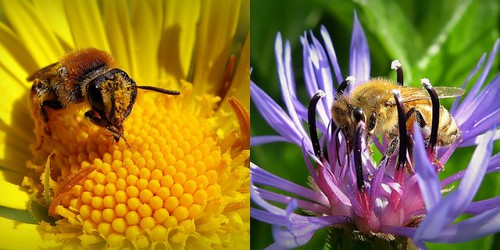
1. And yet another hard worker
2. Behind bars
Hover flies
I have plenty of hover fly photos in my gallery. Based on my experience, they are the easiest winged creatures to take photos of. You can find them on flowers and sometimes they rest on leaves or blades of grass. You can be just inches away from them but they would not care, except if you will shake the leaf or flower. Once you are used to taking photos of bumble bees & honey bees, then you can effortlessly photograph hover flies. You an experiment on many different angles. Hover flies are twice smaller than bumble bees, to capture more of its detail you have to be really close to them.
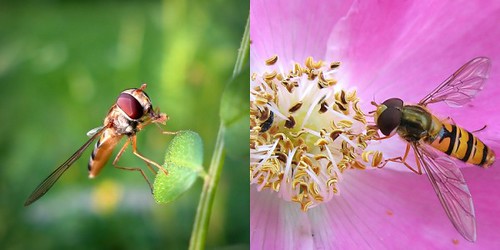
1. A praying hoverfly?
2. in the middle of something
Butterflies
These lovely creatures are probably everyone's favorite insect. Photographing them is quite challenging. Once you see one on a flower, approach it slowly. Your mere shadow will ruin your chance to take photos of these winged insects. So try your best not to cast your shadow over it. If you startled accidentally, it will fly away. But don't fret, because it will come back to the same spot where you saw it. I've seen it happen several times. Like when I took these photos:

1. A summer remembrance
2. Monday blues
The first time I saw a huge moth was when I was 5 years old. It was orange with beautiful patterns on its wings. The wing span of that moth as about 18-20 centimeters. It was my mom who saw it first. Until now I remember how that moth looked like. Sadly, it was the first and last time that I saw such a beautiful live moth. I saw something that looked almost like it but it was in a butterfly museum in Asia, pinned on a wall. I probably would never see anything like that in this lifetime. So while some species are still alive, let's not waste the opportunity. Photograph them while you can. A few decades from today they may no longer be around, but if you took the risk of getting up close to those critters then you will have beautiful pictures to show to your grandchildren someday.
“All nature's creatures join to express nature's purpose. Somewhere in their mounting and mating, rutting and butting is the very secret of nature itself.”~ Graham Swift
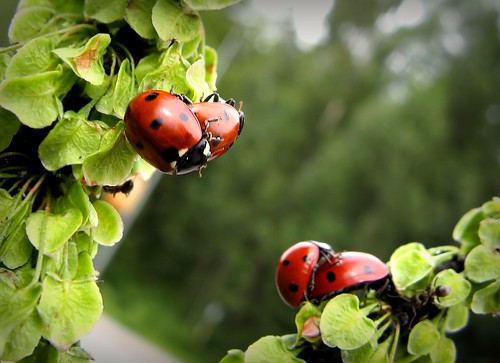 Make love, not war
Make love, not war
Location: Pähkinärinne, Vantaa. Southern Finland
Date & Time: June 28, 2008 4.09PM EET
Camera: Canon PowerShot A710IS
Exposure: 0.008 sec
Aperture: f/4
Focal length: 5.8mm
Among the advantages of a compact camera is that its size and weight won't interfere that much with your daily routine. Take the photo above as an example. I took that on the way home from the grocery and I had two shopping bags at the time. I can't imagine taking photos of bugs by the road side with a heavy DSLR while carrying bags of groceries I am not strong enough to do that.
It's so easy to take photos of insects while they are mating. You can take 100 photos of them is you are quick enough. But that will leave you with so much work afterwards. If you want to upload the photos later to your online gallery, it's a must to pick the best ones, otherwise the photo viewers may get bored to death except of course if they are entomologists who would like to carefully document the bugs' mating process. Once you see a mating pair, don't be afraid to get very close to them. Trust me, they would rarely mind your presence unless startle them by moving the leaves or petals where they are. But when do they mate? The earliest time of the day when I saw mating butterflies was at 11 AM. I once took photos of beetles mating at 7 PM, the evening light was nice then. Of course if there is a butterfly park near you, there would always be mating couples there. But if you are like me who don't have much choice but to look for them in the wild, you have to be alert. Once you see two of the same kind of butterfly, there's a big chance that they are in the middle of a courting ritual. Try not to disturb them and just walk closer to their direction when they get down to the actual business. Beetles are easier to capture because they don't move much. In addition to that, they mate for hours. You will have a lot of time to take photos them. When I was on vacation in the Philippines, I saw mating tortoise beetles while I was on my way to a nearby mall. I took photos of that couple and then after my 2-hour mall trip, they were still at it. Get the picture?
Presenting.. my porn collection:
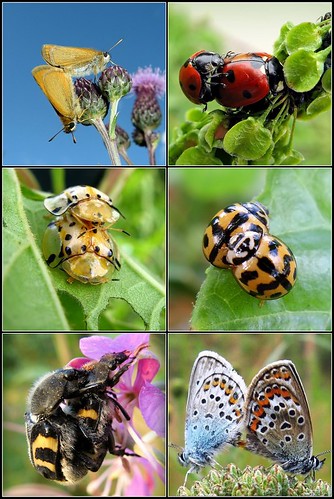
1. Caught in the act, 2. Size doesn't matter?, 3. Afternoon delight, 4. bugs in love, 5. mating beetles, 6. mating butterflies
If you find those photos funny & interesting, why not give insect porn a try? Forget about giving those bugs some privacy, they do it by the road side for crying out loud. Just look for them and keep in mind that sex sells.
“Luck is what happens when preparation meets opportunity” ~Seneca
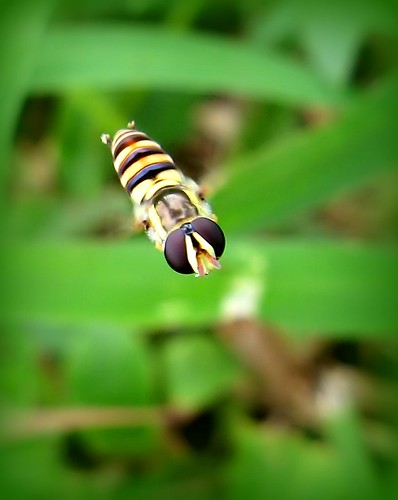
Hover fly in flight
Location: Filinvest Alabang, Muntinlupa Philippines
Date: January 1, 2008, 3:23 PM Manila time
Camera: Canon PowerShot A710 IS
Exposure: 0.017 sec
Aperture: 3.5
Modifications: Cropping, adjusted brightness, noise reduction
If you have visited my Flickr photostream, you may have noticed that usually my reply to comments is: "it's just a lucky shot" especially when it is about photos of insects in flight. I even referred to the photo above as 'my ultimate lucky shot', why? Because it really was. I took that photo while I was in the Philippines. It was the first day of the year and I was my nephew's baby sitter for the day. We were walking along Filinvest Avenue in Muntinlupa. Of course I was prepared to take photos. I hoped to find lady bugs, but I didn't find any. Then I noticed a bug in stationary flight! Oh joy, oh rapture! If I may borrow that line from Helga G. Pataki. I normally take more than 10 shots of my subjects but that time, I didn't have the chance to press the shutter more twice. Thanks to little Clarence John for scaring the bug with his hand. When I asked him why he scared it away, his response was: "it may bite me". A piece of advise: if you want to capture insects in flight, don't bring a kid along, it's for your own good. Fortunately one of the photos turned out okay and it's my most interesting photo to date.
Okay so I did it once, big deal, but can I manage a shot like that again? The geek in me analyzed the probability. Based on my experience, taking photos of bugs in the Philippines wasn't exactly a walk in the park. I think the warm climate is the culprit, it makes bugs hyperactive. The temperature during summer months here in Finland will never match the summers in the tropics. That means that insects here can't be as restless. In a addition to that, my nephew doesn't live here, so I though maybe I can capture bugs in flight again. It shouldn't be impossible. And besides taking photos of insects on flowers or leaves has become too easy for me. I wanted to challenge myself that's why not so long ago, I set a goal to capture bugs in flight, while they are around. I found out that it is not time-consuming because you will only have a few seconds to press the shutter. I considered that as a good thing because at least I was able to attend to other things in the backyard like weeding & watering the plants.
Here are some of my bugs in flight photos:

1. Ready or not, here I come!, 2. captured in flight, 3. Almost there, 4. Off to the next destination
"How did you do that?", some viewers asked. Well, I was prepared to capture those critters and grabbed the opportunity to fire a few shots at them while they were in midair. Based on Seneca's quote, I can consider it as luck. So if you want to take photos of flying insects, remember that you need patience, camera and luck :-)
“If we had no winter, the spring would not be so pleasant: if we did not sometimes taste of adversity, prosperity would not be so welcome.
~Anne Bradstreet

A smoking tulip
Location: Anttola, Eastern Finland
Date: May 23, 2008
Camera: Canon PowerShot A710IS
Exposure: 0.002 seconds
Aperture: 5.6
Focal length: 5.8mm
Modifications: cropping, adjusted brightness & contrast levels
Autumn is here whether I like it or not. So I've got no choice but to divert my attention to beautiful things before this season makes me clinically insane. Now kindly join me as I reminisce about lovely days of spring.
Spring means colorful flowers are back to life. My favorite spring flowers are hepaticas and tulips. I took several photos of them 3 months ago. To make my photos less boring, I experimented with different angles. I found out that shots that are focused on the tulip's inner parts are not that appealing. Whenever I take photos of chrysanthemums I do my best to focus on the flower's center but that didn't work well with tulips. Since the top view wasn't great, I took photos from the bottom, logical isn't it? I took the "smoking tulip" photo by holding the camera inches below the flower's receptacle and hoped that the focus would be on the petals. It was a trial-and-error process, but seeing how the tulip's color stand out against the blue sky was a delight. That perspective also gave the illusion that the tulip was so close to the clouds making it look like a colorful chimney. If you want to try this unusual POV, it's necessary to use flash otherwise the petals would look too dark because of the shadow from the flower itself.
More spring beauties:

1. Kiss the cloud goodbye, 2. You've reached a better place ...
Hepatica
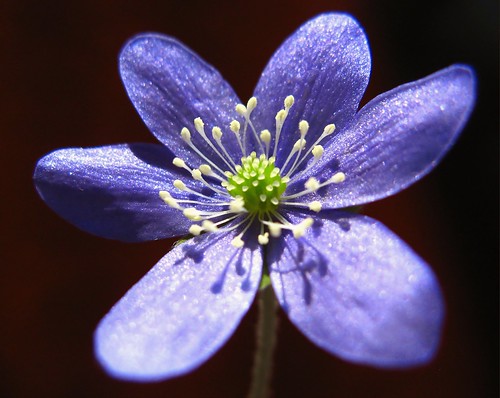
Location: Vantaa, Finland
Date: April 20,2008, 6:22PM
Exposure: 0.017
Aperture: f/2.8
Focal length: 5.8mm
I picked this dainty flower in the woods and brought it to our balcony for photos. The evening light was just right for taking photos at the time. The flower's lime green part looks like a candy, it's interesting, hence I did my best to focus on that. Some said that the petals didn't look nice and that aperture wasn't right for the photo. Okay, fine.. so there are imperfections in the image, no big deal. What matters is that I know that my effort was perfect. I also had fun shooting and the most important thing is I have images that will brighten up my mood..helping me keep my sanity.
“Motivation is what gets you started. Habit is what keeps you going.”
~Jim Rohn
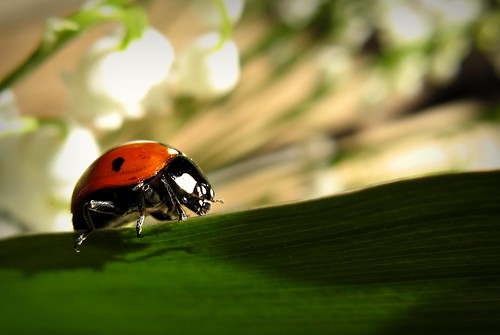
Location: Pähkinärinne, Vantaa ,Finland
Date taken: May 26, 2008 at 2.56pm EEST
Camera: Canon PowerShot A710IS
Exposure: 0.003 sec
Aperture: F/4
Focal length: 5.8 mm
Modifications: adjusted brightness & contrast levels, cropping,
noise reduction, added vignette
I picked this lady bug photo for this entry because I want to talk about my little accomplishments in the field of photography. If you think you couldn't bear reading this entry,
that's fine with me, just let me go on blabbing before I hit the sack. So here it goes...
In August of 2007, my shield bug photo was used for the article Ancient Giant Insects Breathing Easy. I was novice then, so the thought of my photo being good enough in the eyes of another person somehow felt nice. But who knows? Maybe the writer was just too desperate for images :-)
I was in the Philippines earlier this year. While I was there, my butt got featured in Manila Bulletin's Picture Perfect section.

I didn't expect to see 6 of my photos in a national broadsheet. It was a big thing for me. It was also the first time for me to see the printed versions of my work. They didn't look bad. Picture Perfect is a good read for hobbyists. They sometimes feature tutorials & camera reviews. Unfortunately, I can't read anything from their column anymore, it always says "no other news". They should have that fixed. It worked in early summer though. Mr Eric Lirios wrote an excellent article about a certain point & shoot user :-) But because I was already here in Finland then, I didn't get to see the printed version right away. I had to ask someone to send me a copy of that paper. It was so wrinkled when it got here. I haven't taken a photo of it yet.
This morning I got a copy of JPG magazine from the mail. My spotted tortoise beetle photo is on page 94. It was among the photos that were chosen by the magazine's staff & JPG's members to be published for their Creatures feature. There could have been a short story about that pic, but regrettably, I noticed their e-mail too late. Darn! Maybe I was too busy with Flickr then.
So what's next? I don't know yet. I still learn new things everyday. Among my goals is to prove that in photography sometimes you won't need heavy gears for your work to be recognized. I guess I am doing okay.. so far.
A smile is a curve that sets everything straight.
~Phyllis Diller
" 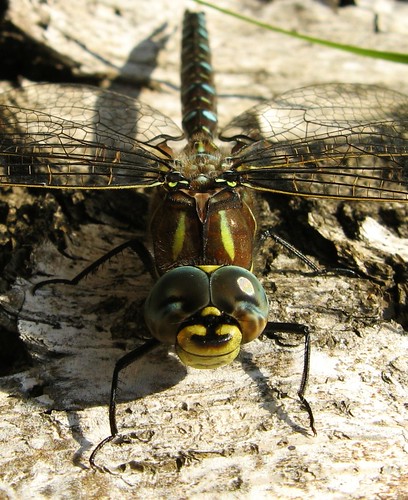
Camera: Canon PowerShot A710 IS
Location: Vantaa, Finland
Date & time: September 25, 2007 at 3.23pm EEST
Exposure: 0.002 sec
Focal length: 5.8 mm
Modification: cropping
It's another gloomy day here in the country. It's been raining and the temperature is 10 degrees centigrade. Not a good day to go out & take photos. The weather really affects my mood. I don't like autumn because it's the prelude to the dark winter and it's sad to see less of my favorite subjects.
A few hours ago, I was looking at the photos that I took at this time of the year because I wanted to know which insects will still be around 'til late autumn. I couldn't help but smile when I saw the above-posted pic. I took that photo after a long day at work. It was not that cold then, so I decided to walk around the nearest pond hoping to see lady bugs or any insect. I was so happy when I saw that dragonfly. I slowly walked close to where it was. It made a stop on a blade of grass and when I was about to press the shutter it flew to a tree, bummer! I had no choice but to get on my feet again and walk to the tree where my subject was resting. I took 5 photos of it. I was a bit surprised because it didn't seem to mind the camera even if it was very close to its face. It flew after the 5th shot and I headed home with dirty jeans. I didn't notice that I was kneeling on wet grass when I was taking photos. When I got home, my husband knew what I had been doing outside, based on how disheveled I was.
I laughed when I first saw this dragonfly pic from my laptop. It was smiling at me! Cool isn't it? Thanks to the nice natural light, because I didn't have to do much to the photo. I just cropped it.
Migrant hawkers should be around 'til late September, I just hope that I could spot some of them here. I wouldn't mind getting my jeans dirty again especially if they will smile for me.
"From small beginnings come great things"
~ Proverb
 My first sharp bumble bee photo
My first sharp bumble bee photo
Location: Savonlinna, Finland
Date & time: 2007:06:28 14:22:31
Camera: Canon Powershot A540
Aperture: f/5.5
Focal length: 23. 2 mm
Exposure: 0.002 sec
Modifications: cropping, adjusted brightness & contrast, color levels
If you want to see the unprocessed image click here. I cropped it the wrong way, my bad. What was I thinking? The head of the bee almost didn't make it to the frame. There should have been more space in that direction. I also wasn't close enough to the subject. The DOF is okay though, and that pollen on its leg adds interest to the image. I only noticed that when the image was already in my laptop. I was quite amazed and the rest, as they say, is history.
I upload my best (to me) photos to my Flickr gallery. I get comments from other members and sometimes e-mails. They basically ask the same questions, I don't mind replying though. So while I'm at it, here are the top 10 questions from viewers of my gallery with my corresponding answers:
1. What's the camera that you use?
For those of you who have Flickr accounts, you probably know that under the photo tags there are more information about the photo. The camera model is there, and if you will click on "more properties" you wil find the EXIF data of the photo. Everything is there: settings, time, the color of my shirt when I took the pic, yeah everything. But I never whine whenever they ask me that question. My standard reply is: a Canon Powershot A710 IS.
2. Do you use a macro lens?
I don't because I don't have one. I don't even know if I can attach anything to my camera.
3. Do you use a tripod?
Nope, my husband has a tripod but I don't use anything that is not mine :-) lol! All of my photos are hand held shots because a tripod may just get in the way if I would stalk bugs. I am quite clumsy, I may trip on it or something.
4. It's crisp, how did you do that?
Natural lighting is the best. I don't take photos on an ugly weather.
5. Where do you find your subjects?
They are everywhere.We have a big backyard where I find different kinds of insects & spiders. I find true bugs on leaves. Bees are always close to the flowers. Spiders are sometimes under the leaves. Bigger beetles always crawl on soil, but ladybirds are on leaves where aphids are close by.
6. Why don't you get a DSLR?
Because I don't want to. It's too heavy and looks too darn complicated to use. It took me half-a-year before I got used to the buttons of my compact camera, so it would probably take me years to learn how to use a DSLR.
7. Why bugs?
I hate to answer a question with a question, but my initial response is: why not? Taking photos of insects is very challenging. Like I've said many times before, anyone can take photos of buildings and landscapes, but not everyone will be patient enough to chase tiny winged creatures. It's the thrill of the chase.. literally.
8. Did you take those photos yourself?
This is the most annoying question ever. I got rashes from stinging nettles just to take photos of ladybugs. ..I was chased by an army of mosquitoes on the way to the forest to look for butterflies I also got bitten by ants while taking photos of hover flies.. and I will be accused of uploading photos that I didn't take?! I don't understand how people can be so cruel. I answer them with a polite 'yes' even if they got me so irritated.
9. What camera can you recommend?
I don't know. I really don't. But if it's a compact point & shoot don't get a camera because it's cute slim and very light. It's super lightness is a disadvantage because you may not be able hold it steadily while taking a photo. You will get out-of-focus images as a result.
10. What's your messenger ID?
I never reply to that question :-)
Hi everyone! Welcome to my photography blog. I want to share with you my views on photography thru this site. I consider myself as a beginner in photography because I've still got a lot to learn. I am enjoying the learning process though. I am grateful for those people who shared their knowledge with me back when my photos were super crappy. I am not saying that they are perfect now, but I get nice comments from those who know more about the craft. So if they were telling the truth, then I guess I could say that I have improved.
According to the writer Johann Wolfgang von Goethe, "We know accurately only when we know little; with knowledge doubt increases." I couldn't agree with him more. The more I learn about photography, the more I realize that my knowledge about it is quite miniscule. There are still so many technical terms that are unfamiliar to me. To be honest, sometimes I think that I may never learn those in this lifetime but it doesn't matter because my photos aren't ugly- at least according to my belief :-)






















